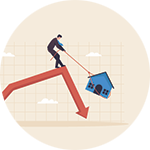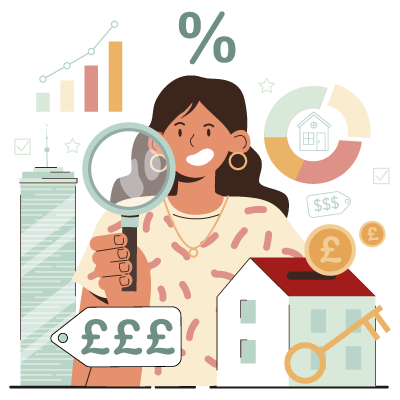Mini-housing Bubble Still Waiting to Burst
- December 2023 saw the worst-ever sales volume of 26,341 for the month, 61% down on December 2022.
- House prices remained close to record highs at £293,008; only 1% down on February 2023.
- Inflation falls to 3.2%, but the Base Rate is set to remain at 5.25% well into the summer.
- Mortgage lenders increase mortgage rates before the base rate drops.
- Property Mark reports, "Prospective buyer registrations stall".
- Inflation is forecast to halve in a matter of months and drop below the target rate of two per cent.
- An average-priced new build is £107,000 more expensive than the average-priced home in England and Wales.
- Read our local housing market reports for - London, Kent, Hampshire, West Midlands, Essex and West Yorkshire.
The mini-housing bubble is still here and growing in April, and it is clear how it is growing. In 2023, sales volume fell every month year on year, starting in January at -21% and ending in December at -61%. There is no data for 2024 volume from the Land Registry yet, but all signs suggest that some confidence has come back to the housing market since the base rate stopped increasing and inflation started to fall.
How long this will last depends on the messaging from the Bank of England on when a base rate cut will likely come. This week, some mortgage lenders raised mortgage rates amid changing expectations for when the Bank of England will begin interest rate cuts. Markets have pushed back their expectations for the first cut in interest rates as inflation proves more stubborn than expected. This will mean it'll be harder for buyers to obtain affordable mortgages and potentially slow down the release of the mini-bubble seen in January and February mortgage-approvals, which were up in 2023 by 29% and 28%, respectively.

In Propertymark's February Housing Insight Report, they see signs from their member branches that buyers are already falling away in 2024 as they state, "Although the average number of new prospective buyers registered per branch increased considerably in January 2024, momentum appears to have stalled with fewer buyers registered in February 2024 than in February 2023". In February 2023, the base rate was 4%, meaning there would have been more mortgage products at affordable rates for buyers compared to the 5.25% rate in 2024.
There is hope, though, as the UK economy looks to be generating momentum, with growth at a “turning point”, according to BDO. They found that output reached its highest level since May 2022 in March 2024, and inflation fell to its lowest point in over three years. Confidence in the overall markets is good for the housing market.
I expect the normal seasonal trends to kick in and buyers come back in greater numbers this summer once the base rate falls, triggering more affordable mortgage rates. We may see flatter growth in March and April's volume numbers when released between then and now.
Buy-to-let landlords catch a break!
The Renters’ Reform Bill has passed the House of Commons; however, MPs postponed a ban on “no-fault” Section 21 evictions until a review of the court system has taken place. Section 21 notices, which allow landlords to end tenancies at will with two months’ notice, were first announced in Parliament in 2019.
The Renters Reform Coalition accused the government of “betraying renters” due to the delays in scrapping Section 21 notices. Landlords can still evict tenants at will, offering them greater flexibility to achieve higher rents from new tenants.
Read more - What is the process to evict a tenant?

When will the base rate fall in 2024?
Huw Pill, the Bank of England’s chief economist, has said that interest rate cuts remain a “way off”. He insisted that the fall in inflation to 3.2% is not a reason to ease monetary policy but an indication that “the restrictiveness of monetary policy is starting to have its desired effect”. Earlier this month, Megan Greene, a BOE policy maker, stated that investors are underestimating the risk that inflation will last longer in the UK than in other advanced economies. Ms Greene pointed to the UK as having faced a very tight labour market and a far bigger energy price shock than the US.
The Bank of England will also know that the European Central Bank held interest rates at 4.5% for another month. They, too, are seeing inflation fall across the eurozone and the markets are expected to see the first interest rate cut in June.
There is now talk the base rate change could be as late as August or September. I still anticipate the base rate will be cut before then, as we see the unemployment total rise by 85,000 to 1.44 million from December to February and slow to falling wage growth.
Are New Builds fueling the Average Sale Price in England and Wales
For years, new builds have cost more than the average house price in England and Wales and have had noticeable jumps in the summer of 2016 and April 2018. The jump in 2023 means an average-priced new build is now £107,000 more expensive to buy, at £401,231. The difference was only £38,839 10 years ago. This disparity in price will fuel house prices up as estate agents use these potentially over-priced local comparables when setting sale prices for existing properties in the local area.
My opinion is echoed by Rightmove as they state asking prices rose to near-record levels in April this month. The average asking price for houses coming to the market rose to £372,324 in the four weeks to mid-April, just £570 short of the average price in May last year, which was the highest level since Rightmove started collecting the data in 2001.
Lowest sales volume for December
London 
London has the lowest sales volume for December since records began, achieving just 2,616 sales, 63% down on the previous year's 7,037. Even after the financial crash of 2008, sales in December only fell to 4,505. For more on London, read: London Housing Market Report.
Average house prices in London fell year on year by 5%, to £502,690, for February 2024.
England & Wales
England and Wales echo London with a 61% fall year on year, making December the worst on record at 26,341 property sales. We now know the economy slipped into recession during this time, while mortgage interest rates were high, so expect volume increases from January onward as Land Registry data is released.
Are UK house prices falling?
Average house prices in England & Wales fell year on year by 1% to £293,008 for February 2024.
Mortgage reports
Home buyers
Mortgage approvals for home buyers grew in February to 60,383, up by 28% on last year. This shows more confidence in buyers with more affordable mortgage products. We may see this fall in future months if more mortgage lenders choose to increase their interest rates before the anticipated base rate fall.
Remortgages
The remortgage growth was less confident than for home buyers, with a 25% YOY increase to 37,698. This is unsurprising after the previous year's demand for household income. Barclays reported that one in six people aren’t confident in their ability to meet mortgage payments each month across the UK. If you're struggling with repaying your mortgage, you'll likely be worried that you won't pass affordability checks on a remortgage.
There is light at the end of the tunnel because housing costs are stabilising after years of increasing payments. According to an analysis of millions of Barclays' current accounts, the amount people spent on mortgage repayments and rent rose by 1.8 per cent in March compared with a year ago. This is far lower than the rise of 12.2 per cent recorded in June 2023, when growth was at its highest. It is the lowest year-on-year increase since March of the previous year. I expect to see a flurry of remortgages throughout the summer and onward as the cost of living comes down, along with base rate and mortgage interest.


Andrew Boast FMAAT
CEO of SAM Conveyancing
How is the current UK housing market?
Spring will show an increase in sales volume that is more in line with 2022 than the stagnant 2023, offering opportunities for home buyers and homeowners alike. With more affordable mortgage products and the reduction in the cost of living, the housing market can take a breath after a very exhausting 18 months.
While the Bank of England states that a base rate fall is "way off" at the moment, this message is meant to calm mortgage providers and the markets so they can plan further ahead through May and June. The delay will help reduce inflation closer to the target of 2% and ensure a longer term of stability through the rest of 2024 and 2025.
The major curve ball to this is the General Election and what would happen if there was a changing of the guard.
Sources: Latest data from - Gov.UK, Bank of England, UK House Price Index, ONS and Property Mark (NAEA).

Without Killing Anyone
This book could be the difference between every mover’s dream, buying and moving into your new home stress free, or, stress, missed deadlines, legal disasters, building defects, and possibly the collapse of the whole transaction. (Costing you a small fortune, a head full of grey hairs, and, driving you to threaten the life of your solicitor, lender, co-owners, family, partner, or some combination of all five).
With more than two decades’ experience in the conveyancing sector and over 50,000 successful client moves under his belt, Andrew shares insider tips and advice to empower you as a buyer, giving you the tools to make the best decisions for your circumstances and ease the chaos.
Available on Amazon | Kindle | Paperback












